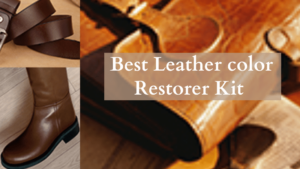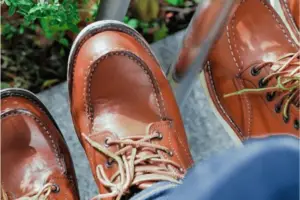How to glue leather to wood
In this article, we explore an exciting DIY technique of how to glue leather to wood so that you can add a touch of luxury to your furniture.
Gluing leather to wood is a simple but effective method that can transform any wooden piece into a work of art.
So whether you’re looking to revamp an old piece of furniture or start a new project, this article has got you covered.

How to glue leather to wood
To glue leather to wood, you need first to roughen the surface of the leather and then apply a coat of contact cement. Let it become tacky before applying a single coat of adhesive to the wood surface. Place the leather on top of the wood making sure it is aligned and press and hold for a few seconds.
Here are the steps to effectively attach the leather to wood for your DIY project.
Step 1: Gather the materials
You will need; Leather, wood, contact cement, sandpaper, a ruler, a cutting tool like a utility knife or scissors, a foam brush, weights or clamps, and a rag.
Step 2: Clean the leather and wood
Give your wood and leather a good old-fashioned clean with a damp cloth to get rid of any dirt, oil, or gunk.
Make sure everything is as dry before moving on to the next step.
Step 3: Sand the leather
This is an optional step but it is highly recommended to ensure the leather surface is smooth enough for better adhesion.
Choose sandpaper with a grit suitable for your type of leather. For instance, fine grit like 220 is ideal for smooth leather while coarser grit 120 is ideal for rough textured leather.
Sand the leather in a circular motion but be careful not to sand too hard or for too long in one spot as this can cause damage to the leather.
Once done, dust off using a soft brush or cloth to remove the residue created from sanding.
Step 4: Apply adhesive
Contact cement is highly recommended for this project because it is specially formulated for use on leather.
It creates a strong and flexible bond between leather and other porous materials so using it will give you the best results.
Start by applying a thin layer of the adhesive to the sanded surface of the leather and then let it become tacky for a few seconds.
Apply another thin coat and let it sit on the leather and become tacky once again.
Since contact cement is a one-part adhesive, you will need to apply it to the wood surface as well.
Step 5: Place leather on wood
Once you have applied the adhesive, place the leather on the wood making sure the pieces are well aligned.
Press and hold the two pieces together until they adhere to each other.
Since the drying time can take up to 24 hours, you can add some weights or clamps to hold the two pieces together until the adhesive is completely dry.
Step 6: Test the bond
Once the adhesive has dried, it’s time for you to test the bond.
The drying time will depend on the specific adhesive you used and the temperature and humidity of your environment.
Once it’s dry, gently tug on the leather to ensure that it is securely bonded to the wood. If the bond is not strong, you can apply a second coat of adhesive and let it dry before testing again.
It’s important to test the bond before moving on to the next step, as a weak bond could result in the leather coming loose over time.
What is the best glue for leather on wood?
When choosing an adhesive for attaching wood to leather, it is important to consider the specific requirements of your project such as the weight, size, and durability needed.
Here’re the three most commonly used types of glue that work best with leather and wood projects.
-
Titebond III Ultimate wood glue
Titebond III Ultimate Wood Glue is the ideal adhesive for all of your woodworking projects.
Whether you are working on an interior or exterior project, Titebond III provides the strength and durability you need to create a lasting bond.
Its water-resistant formula makes it perfect for projects that will be exposed to moisture or harsh weather conditions, ensuring that your work will stand the test of time. It is also easy to clean up with just water in case of a mess.
With a longer working time than other types of glue, Titebond III gives you the flexibility to make adjustments to your project before it sets, ensuring a perfect result every time.
And its polyvinyl acetate-based formula creates a bond that is both strong and flexible, making it ideal for a wide range of woodworking applications including attaching wood to leather.
This glue is easy to use and dries clear, so it won’t interfere with the look of your finished project. Plus, it can be sanded, painted, or stained, giving you even more versatility and flexibility.
-
Leather and wood Super glue
Leather and Wood Super Glue is a strong adhesive that combines the power of super glue with the versatility of a leather and wood bonding solution, making it the ideal choice for all of your leather-to-wood projects.
With its advanced formula, this glue creates a bond that is not only strong and durable but also flexible and water-resistant.
This unique combination of properties makes it perfect for use in a wide range of applications, from furniture projects and leather crafts to repairs and restorations.
Not only does this super glue work on leather effectively but also incredibly easy to use.
Its fast-drying formula allows you to move on to the next step of your project without having to wait for the glue to dry or using clamps and weights.
And, because it dries clear, you can be sure that the finished product will look as good as new, without any unsightly glue marks.
Does wood glue work on leather?
Wood glue can indeed work on leather, but it’s important to choose the right type of glue for the job. Not all wood glues are created equal, and some are better suited for bonding leather to the wood while others create strong adhesion between leather and plastic or rubber.
For example, PVA (polyvinyl acetate) wood glue like Titebond III Ultimate Wood Glue is a popular choice for leather projects due to its strong and flexible bond.
Conclusion
In conclusion, bonding leather to wood or any other material like fabric can be a seamless and successful process with the right tools and techniques.
By properly preparing both the leather and wood surfaces, selecting a suitable adhesive, and following the manufacturer’s instructions for application, you can achieve a strong and lasting bond that will enhance the beauty and durability of your leather-to-wood project.




